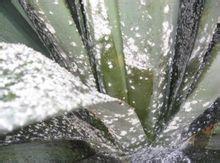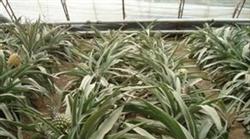Experience of off-season and high-yield cultivation of pineapple

According to the requirements of pineapple to the external environmental conditions, the sloping land with mild winter cold damage, no frost or less frost and soil pH value of 4.5-6.0 was selected as the garden. After selecting the garden plot, build horizontal terraces around the mountain according to contour lines, turn 40-50 cm deep, thoroughly dig weeds such as thatch grass, and dig flood control ditches and drainage ditches according to the area of the plot. II. Timely planting, reasonable close planting pineapple planting time is not very strict, except December to January of the next year cold and drought is not suitable for planting, the rest of the time can be planted. Pineapple cultivated in anti-season should be listed in March to April in the off-season of the next year after planting, so it must be planted in March, and thick stems, dense leaves, strong mature buds or large buds should be selected for planting. When planting, it is required that the buds have more than 10 large leaves and the fresh weight is more than 200 grams. According to the production practice, the local planting density is 1000-1200 plants per mu. Third, reuse potassium fertilizer, apply enough base fertilizer pineapple fast-growing and high-yield, potassium needs a lot, so apply enough base fertilizer, reuse potassium fertilizer is an important measure to win pineapple high-yield. Base fertilizer to plant ash and soil fertilizer based, with a small amount of calcium superphosphate, 0.25-0.5 kg per hole. Practice has proved that applying sufficient base fertilizer is beneficial to improving soil aggregate structure, enhancing soil permeability and water and fertilizer retention capacity, creating a good soil environment conducive to pineapple root growth; at the same time, nutrients can be absorbed after seedlings survive, accelerating the growth of roots and leaves, and promoting plant growth and early bearing. In addition, applying sufficient plant ash and other basal fertilizers can improve the cold resistance of plants. 4, timely topdressing, strengthen management 1, timely topdressing seedlings survive, nutrition growth period every 1-2 months topdressing once, each plant applied urea 25 grams, topdressing should be carried out after the rain. In July, the fertilizer is applied again, and 50- 100g compound fertilizer is applied to each plant. In addition, topdressing (0.2%-0.4% urea aqueous solution) was applied 1-2 times outside the roots during the fruit expansion stage. After the weather warms up in February every year, fertilization management should be strengthened, and topdressing should be carried out in time to promote the rapid growth of plants. 2. Covering pineapple root groups between rows is shallow. In order to protect root groups, keep soil moist, inhibit weed growth, reduce summer and autumn ground temperature and improve winter soil temperature, which is conducive to healthy growth of root groups, it is necessary to carefully cover the whole year between rows. The mulch can be straw or mountain grass, and the mulch thickness is 3-4 cm. 3. Pineapple root system is strong and must keep the soil loose and breathable. Between rows and under the leaf crown, the roots are dense and shallow, and those without straw cover should be weeded in time. When weeding, attention should be paid to shallow hoe to avoid damaging roots. Generally in May or so before the flowering of weeds and ground hardening after rain to carry out intertillage weeding 1-2 times. After October, the weather gradually dry, should also carry out intertillage loose soil, drought prevention moisture, in addition to clean weeds. 5. Promoting flowers and fruits in time, adjusting harvest time 1. Promoting flowers After 5-6 months of fast-growing cultivation, pineapple planted in March must be promoted with ethephon in August when the plant grows to more than 35 cm and has 25-28 leaves with a length of more than 35 cm in order to strive for fruits to be listed in March and April of the next year and the harvest period is concentrated. The concentration used is 0.025%-0.05%(with 40% ethephon 100 ml and clear water 80-160 liters), the concentration is lower when the temperature is high, and the concentration is higher when the temperature is low. Adding 1% urea to ethephon diluent had better effect. 20- 50ml of diluted solution is poured into each plant, or the spray head cover is removed with a backpack sprayer, and the solution is sprayed from the center of the plant. Ethephon should be selected before 10:00 a.m. or after 5:00 p.m. on sunny days for flower induction, and buds should be picked 28-30 days after flower induction. The following problems should be paid attention to when using ethephon to promote flowers: (1) The plants to be promoted must have healthy plants with certain vegetative growth basis, that is, 25-28 green leaves with a length of more than 35 cm. If the plants are too small or too weak, they will blossom and bear fruit after treatment, but the fruit yield will be small and the commodity value will be lost. (2)Ethephon is a plant growth regulator rather than fertilizer, so it is necessary to increase fertilizer before and after flowering to achieve the goal of yield increase. (3)Grasp the appropriate concentration of liquid medicine, too high concentration, both waste medicine, but also inhibit growth. 2. In order to achieve high yield and high quality, 0.2%-0.4% urea solution was used for topdressing outside the root to promote fruit development. 6. Topping should be done in time after bud withering, removing crown buds and excessive suction buds, concentrating nutrition to supply small fruit growth, and retaining 1-3 strong buds near the ground as replacement mother plants after fruit picking. Seven, bagging fruit protection pineapple like warm, afraid of frost, should be in the "small cold" before and after bagging fruit protection cold. Pineapple fruit bagging generally use vest bag, easy to hold. Bagging should be careful not to break the bag, and add a layer of paper or cloth in the bag to help absorb moisture and moisture, while preventing freezing. The practice proved that the fruits protected by bagging were large and would not crack, and had high economic value; the fruits without bagging were small and cracked, and had low economic value, thus losing the significance of anti-seasonal cultivation. Eight, pest control pineapple anti-season cultivation, due to the low temperature when the fruit matures, fewer pests and diseases. Therefore, except for the prevention and control of beetle larvae during planting and the prevention of mouse damage during fruit maturity, the rest of the time can be controlled without chemicals, so that the product meets the requirements of pollution-free. Nine, timely harvest pineapple anti-season planting, after planting a year of cultivation management, to the next year in March, April can enter the harvest period, when the fruit base has 2-3 rows of small fruit yellow, fruit handle slightly wrinkled, fruit on the stalk slightly inclined side can be harvested. Pineapple fruit harvest should be carried out in batches, ripening first. After fruit picking, the management of the second growth cycle is carried out. Pineapple's high yield period is generally 2-4 years, and the yield decreases sharply after the fifth year.
- Prev

Pineapple pink scale
The pineapple pink scale belongs to Homoptera and Coccidae. Pineapple pink scale is the most common. The symptom of damage is that adult and nymph damage pineapple rhizome, leaf, fruit and seedling to suck its juice. The damaged leaves begin to show symptoms from the lower part, gradually fade upward and turn yellow and finally reddish purple, and in severe cases, all leaves soften and droop.
- Next

Growing pineapple in greenhouse in North China
It usually takes about a year for pineapple to blossom and hang fruit. Pineapple is also suitable for planting in flowerpots, which can not only make full use of the space under trees, but also can be sold as bonsai in flower and fruit period, which has high ornamental value and economic benefits. Planting in the north should be carried out in solar greenhouses or multi-span greenhouses with heating facilities. Fall.
Related
- Moge, come on! The staff of the peasant association in the producing area of cantaloupe were frightened when the crowd gathered.
- Causes and Solutions of low Fruit setting rate of Apple
- Symptoms and control measures of passion fruit virus disease
- Fruit growing lesson: how do apple orchards keep high yields?
- Can you build orchards in the mountains? What are the pros and cons?
- How to manage the coloring period of Crisson grape?
- This paper introduces the processing technology of two kinds of fig products.
- How much is a month for retired teachers in rural areas by 2020?
- How can strawberry planting increase sugar content? We should pay attention to management in many aspects.
- What are the cultivation techniques on how to improve the yield of golden fruit?

